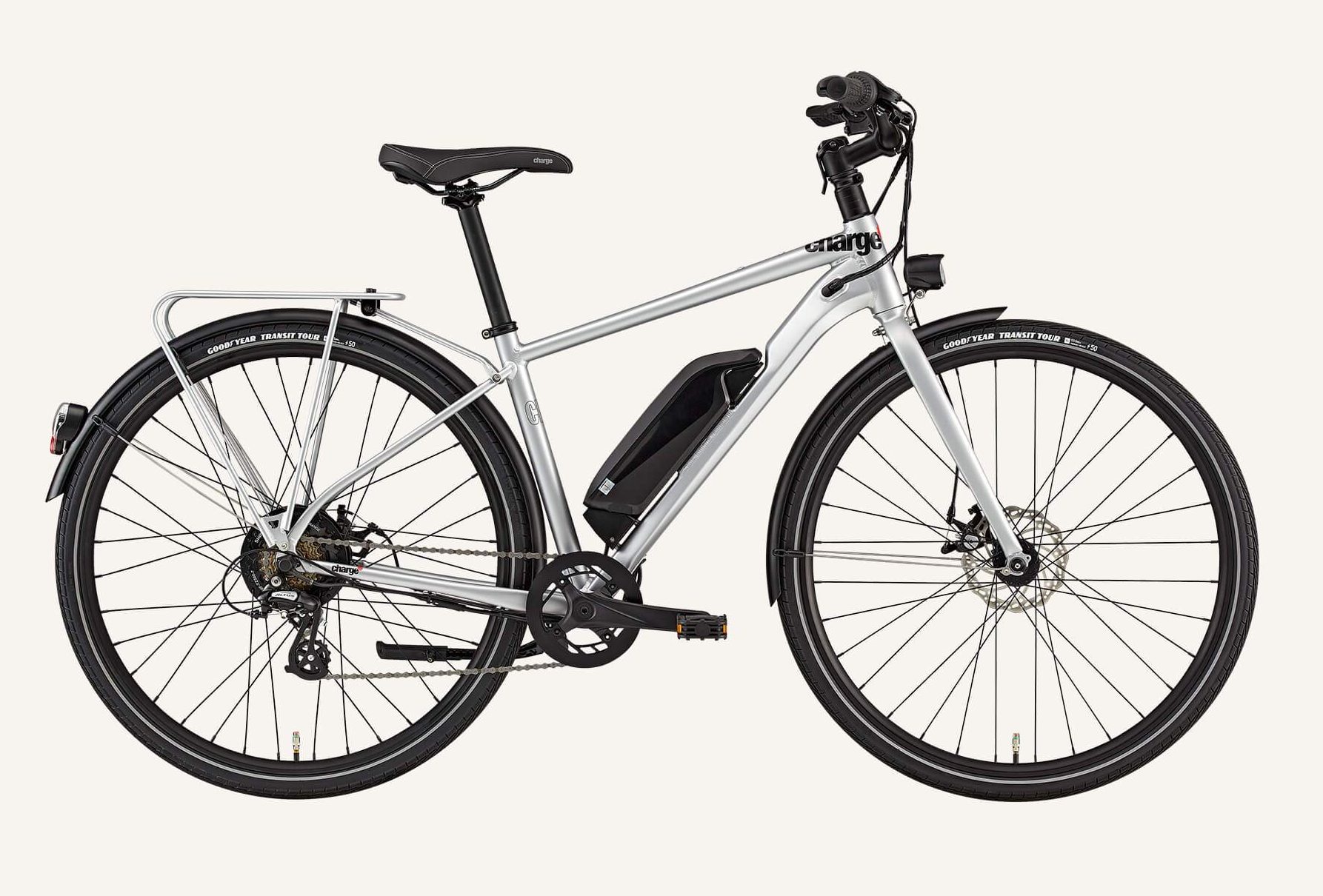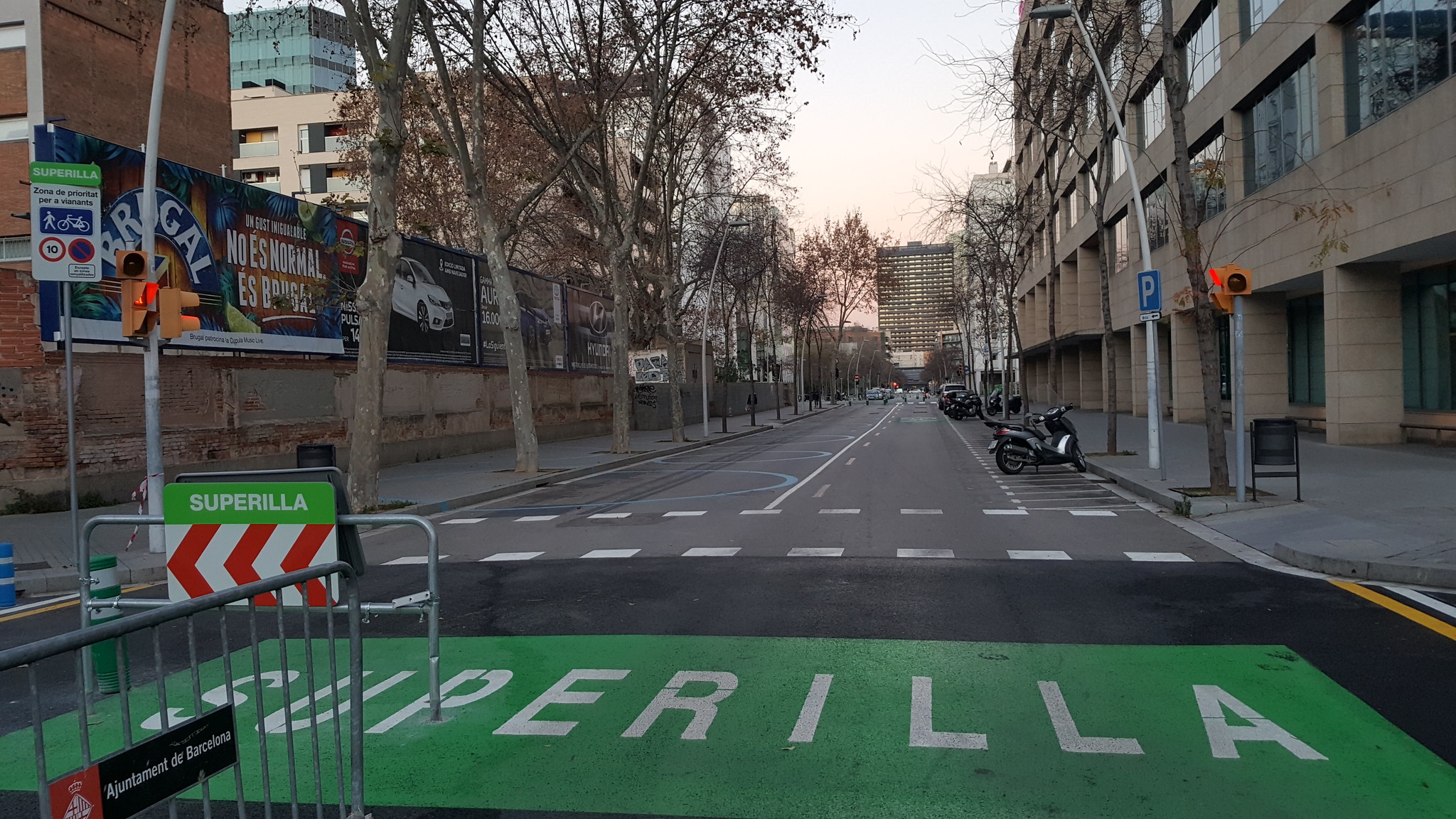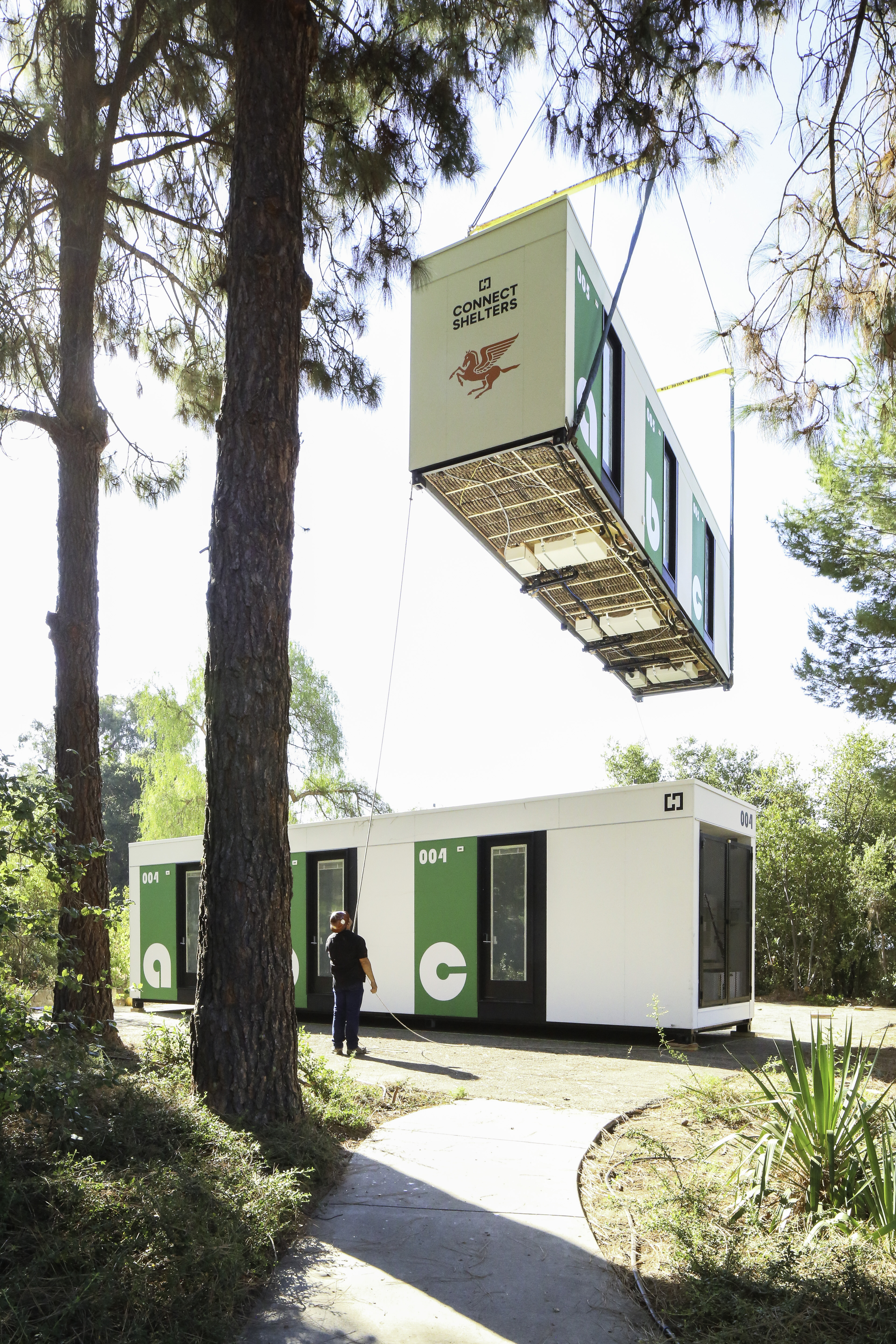The coronavirus pandemic is acting as a catalyst for urban transformation across Europe as city authorities grapple with how to manage urban mobility without risking citizens’ health or inviting gridlock by letting cars flood in.
Micromobility and local commerce are being seen as both short and long-term solutions for urban revival in a number of cases. We’ve run down key policy developments in four major cities, Paris, Barcelona, London and Milan, which — at varying speeds — are pushing to rethink and reclaim streets for feet and two wheels.
Paris’ 15-minute city
Every year, around 2,500 people die prematurely because of air pollution in Paris. Like most European cities, the number one cause of pollution is motorized traffic.
Due to consistent policy changes over the past two decades, pollution has been slowly decreasing. It’s a long and difficult process and each step provides a new set of challenges.
The city has only had two different mayors for the past twenty years — Bertrand Delanoë and Anne Hidalgo. That consistency combined with long terms as mayor has led to some divisive changes and long-term thinking.
Paris has a long and conflictual relationship with cars. Nearly 20 years ago, bus lanes were highly controversial because it reduced space dedicated to cars. Today, nobody is asking for the removal of those lanes.
That’s why it’s a bit ironic that the same thing is happening again and again. For instance, Paris Mayor Anne Hidalgo banned cars from the right bank of the Seine in 2016. Many political opponents and car enthusiasts criticized the decision. Earlier this year, none of the candidate in the municipal election mentioned the right bank of the Seine — it became a non-issue.
But the city’s policies aren’t just focused on banning cars. Paris has become a mobility lab for European cities with many public and private initiatives. If they work in Paris, chances are those initiatives will be reproduced elsewhere.
There are two reasons why Paris is an interesting city for mobility experiments. First, the Paris area is the 29th metropolitan area in the world by population density. Georges-Eugène Haussmann initiated some radical urbanization changes in the second half of the 19th century leading to the city’s modern layout — mostly seven-story buildings circled by the ring road.
As the limits of the city haven’t changed in over 100 years, it is still relatively small compared to other major cities. For instance, San Francisco, which is a small city by American standards, is still larger than Paris when it comes to area.
Second, Paris attracts a lot of tourists (in a normal year). In 2019, 38 million tourists came to Paris. These tourists tend to do normal touristy things — they move around the city all day long.
Vélib’ as the epicenter of mobility changes

Paris Mayor Anne Hidalgo and a fleet of Vélib’ bikes. Image Credits: Loïc Venance / AFP / Getty Images
In addition to a dense public transportation network with subways, regional trains, buses and trams, other transportation methods have emerged. In 2005, the city of Lyon introduced Vélo’v, a publicly subsidized bike-sharing service based on a network of stations spread across the city.
Two years later, the city of Paris introduced a similar servie called Vélib’. It’s hard to overstate how big of an impact Vélib’ has had on transportation. Just a few years after its launch, Vélib’ had hundreds of thousands of subscribers generation over 100,000 rides per day.
Other cities in Europe and the U.S. have followed course and introduced their own bike-sharing service. But nobody has come close to reaching the success of Vélib’. Despite some growing pains, Vélib’ now has over 400,000 subscribers. On September 4th, 2020, the service handled 209,000 rides. There are around 15,000 bikes on the service, which means that each bike is used nearly 14 times per day.
The reason why Vélib’ is much more successful than Citi Bike in New York or Santander Cycles in London is that Vélib’ is much cheaper. A standard Vélib’ subscription with unlimited ride costs $3.70 per month (€3.10). In London, you pay nearly $10 per month (£90 per year). In New York, it costs $15 per month. Subscribing to Vélib’ is a no-brainer.
And this is all due to political will. Vélib’ is a subsidized service. But it’s hard to understand the financial impact of Vélib’ as there are fewer cars on the road, which means that it’s less expensive to maintain roads. Additionally, the impact on pollution and physical activity means that people tend to be healthier, which reduces the pressure on the public health system.
Bike-sharing services can’t work without public money as it fosters network density, which boosts usage. Once the network reaches a critical mass, it’s a never-ending virtuous circle of network expansion and new clients.
Micromobility’s key battleground

Image Credits: Romain Dillet / TechCrunch
Many startups have tried to enter the lucrative market with their own take on bike-sharing without docks. Gobee.bike, Obike, Ofo, Mobike and more recently Bolt have all deployed thousands of bikes in the streets of Paris. They’ve all shut down since then. Jump, which is now a Lime subsidiary, is the only remaining contender.
But bikes are just one transportation method among what people call ‘soft mobility’ in France. A French startup called Cityscoot has also been thriving with tens of thousands of rides per day. The company operating free-floating electric moped scooter service.
And then, there are scooters. At some point, there were just too many scooter startups — Bird, Bolt, Bolt by Usain Bolt, Circ, Dott, Hive, Jump, Lime, Tier, Voi, Ufo and Wind. They all had funny-sounding names and there were even two different companies with the same name (Bolt). And I’m probably forgetting a couple of companies.
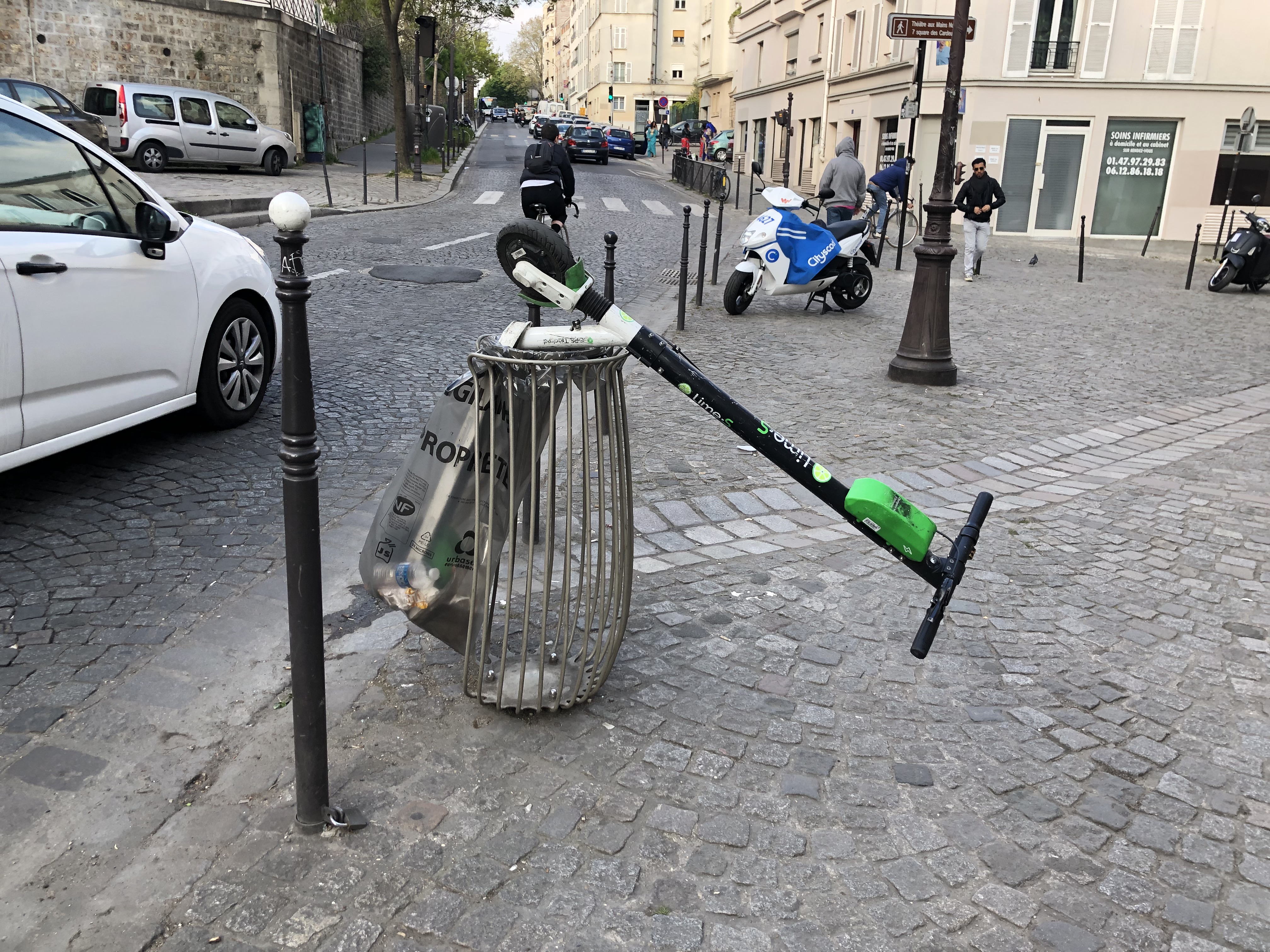
Image Credits: Romain Dillet / TechCrunch
This shows once again that Paris is an attractive city for micromobility startups. There are many tourists and you can go from A to B quite easily.
The city of Paris had to regulate the market because scooters were taking over urban space. There are now three permits to operate shared electric scooters in Paris — Dott, Lime and Tier. They each operate a fleet of 5,000 scooters and there are now dedicated parking spots.
The 15-minute city
Up next, Paris Mayor Anne Hidalgo has some ambitious plans to accelerate the pace of changes. During her reelection campaign earlier this year, she laid out a clear multiyear plan with a key concept: the 15-minute city.
“The 15-minute city represents the possibility of a decentralized city. At its heart is the concept of mixing urban social functions to create a vibrant vicinity,” Carlos Moreno, a professor at University of Paris 1, told Bloomberg.
Essentially, Moreno believes that there shouldn’t be residential neighbourhoods, business districts and commercial areas. Each neighbourhood should be a tiny town on its own with workplaces, stores, movie theaters, health centers, schools, bakeries, etc.
In addition to reducing carbon emissions, the 15-minute concept has the potential of revitalizing neighbourhoods altogether. By prioritizing social functions, roads immediately become an afterthought.
The 15-minute city is a concept that sums up a lot of things in three words. Suddenly, there’s a clear political agenda with a strong brand for the next decade of urban planning.
If I paraphrase neoliberal ideology, many policies trickle down from the 15-minute city. Car ownership is relatively low in Paris — more than 60% of households don’t have a car. Even more striking, people going to work use their car extremely rarely — in 9.5% of cases.
There are two consequences. First, cars are no longer the priority. In 2024, you won’t be able to drive a diesel car in Paris. In 2030, gas-powered cars will be banned.
Some major roads are now primarily focused on ‘soft mobility’. Due to the coronavirus outbreak, the city of Paris took advantage of the lockdown to accelerate their mobility agenda with new bike lanes and repurposed roads. It feels like they’re copying the neoliberal shock doctrine, as explained by Naomi Klein. And yet, in that case, it feels like a reverse shock doctrine as the administration is focusing on green initiatives.
For instance, the Rue de Rivoli used to be a major road that connects the Champs-Elysées to Bastille. Now, one-third of the road is dedicated to buses and two-thirds are reserved for bikes and e-scooters.
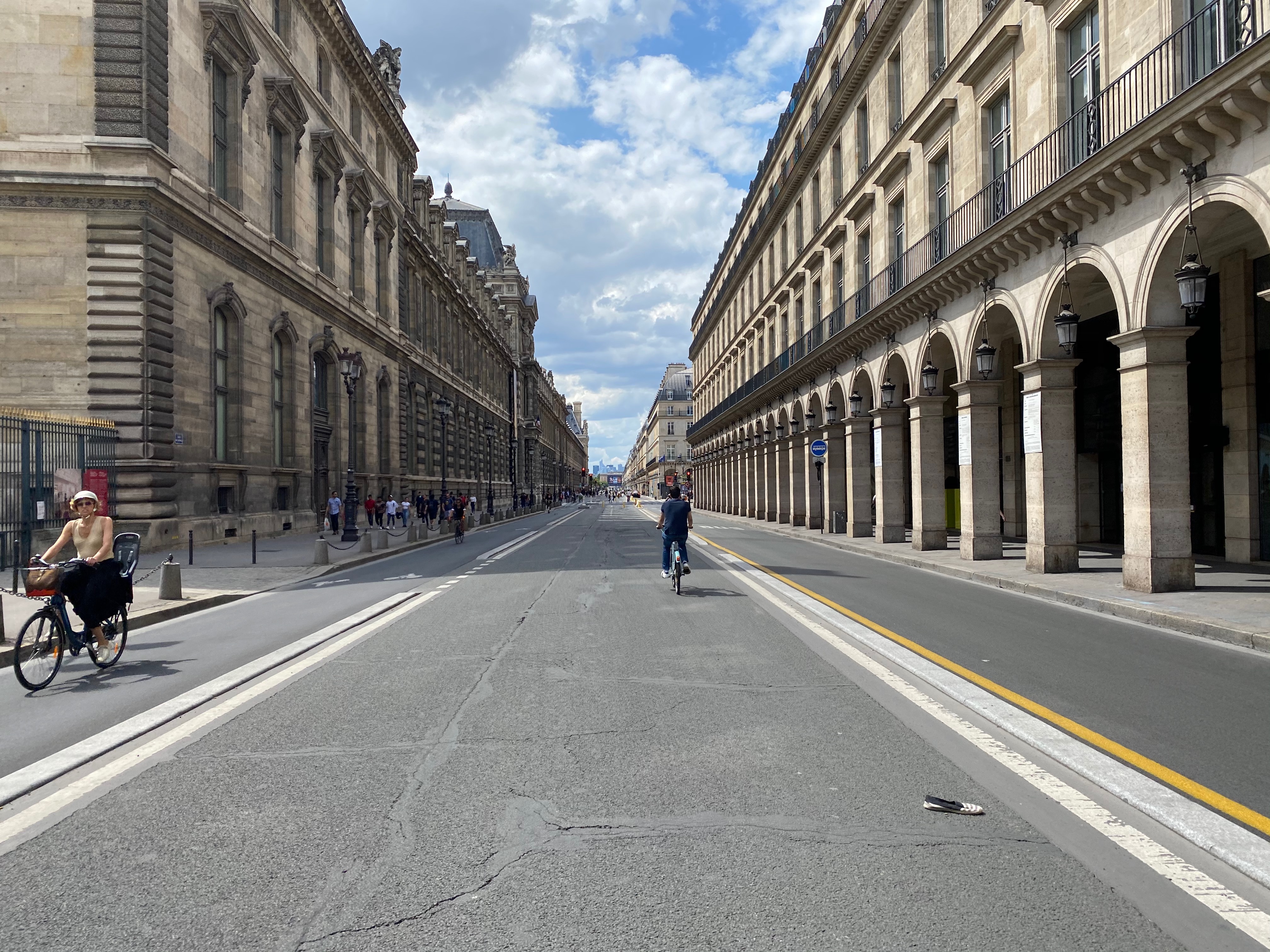
Rue de Rivoli. Image Credits: Romain Dillet / TechCrunch
Second, the City of Paris wants to reclaim space. Cars in Paris remain parked 95% of the time. That’s why Paris is going to remove 50% of parking spots. Instead, the city of Paris wants to turn some streets into gardens. There are bigger plans for new parks as well in front of the city hall and between the Eiffel Tower and Trocadéro.
After decades of incremental changes, everything is lining up for a drastic transition. In Paris, change happens progressively, then suddenly.
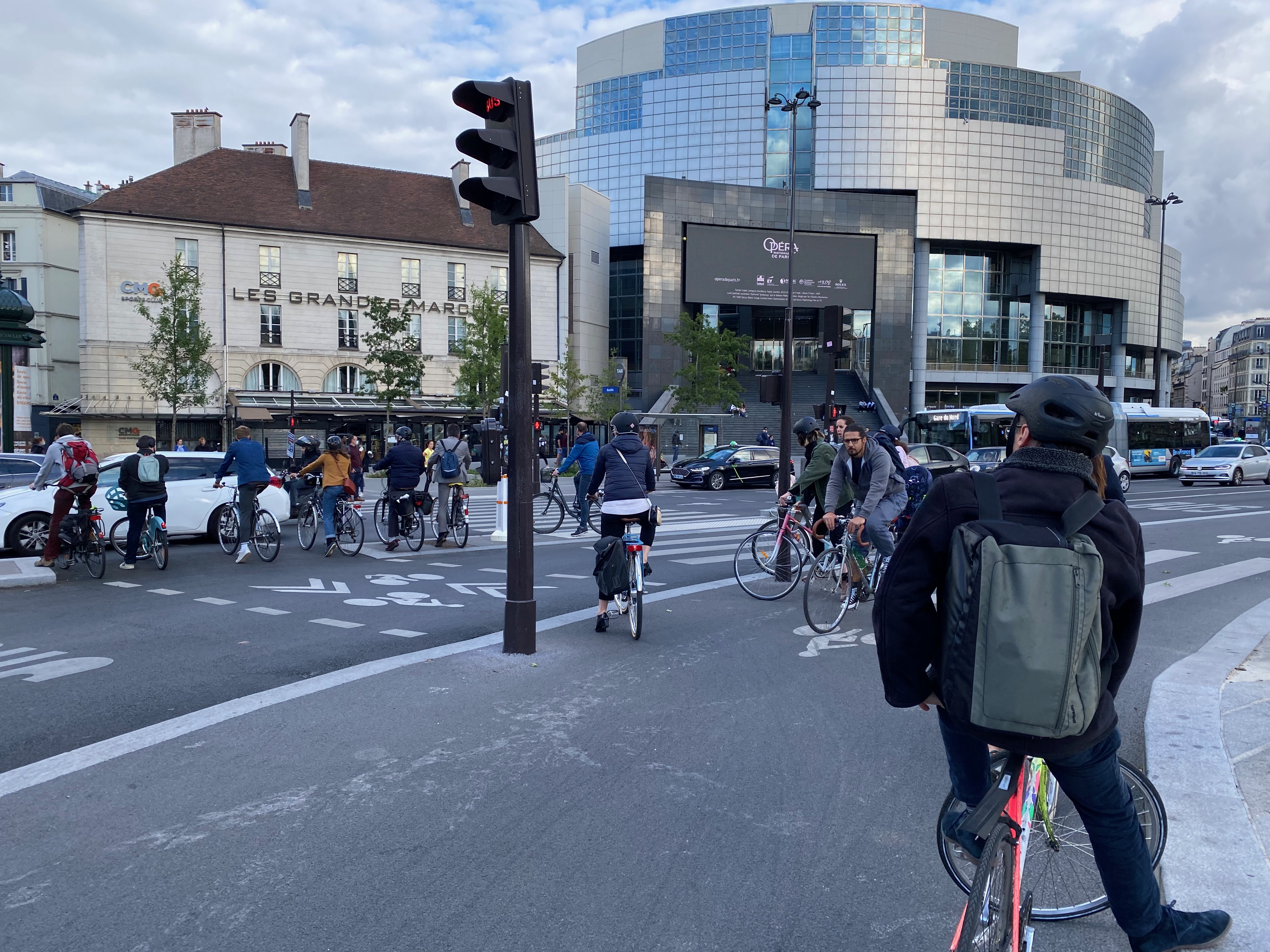
Image Credits: Romain Dillet / TechCrunch
Barcelona’s Superblocks
The Catalan capital — Spain’s second largest city — approved a new Urban Mobility Plan in 2013 with the aim of flipping street space in favor of pedestrians and away from prioritizing private vehicles. The city has the highest vehicle density in Europe and that’s a major problem.
City authorities report vehicle density at around 6,000 per square kilometer — highlighting the deleterious impact on air quality and public health. Per official stats, traffic pollution causes 3,500 premature deaths annually, 1,800 hospital admissions for cardiorespiratory problems, 5,100 cases of bronchitis in adults, 31,100 cases in children and 54,000 asthma attacks in children and adults.
The city’s solution to this public health crisis is an ambitious pedestrianization plan focused, in recent years, on creating ‘superilles’ — also known as ‘super islands’ or ‘superblocks’ — which switch the function of a number of streets from carrying cars to putting neighbourhood life first.
A handful of superblocks have been established over the years. Some, such as one in the Gracia barrio, is already so well established it’s all but invisible to the eye unless you stop to ask yourself how come there are so many pedestrians out and about and the cars that pass have to creep along behind them? Or why the edge of the pavement blends seamlessly into the road with no change of level.
But Barcelona is now planning a major expansion of the policy, championed by mayor Ada Colau, that will see it transform the dense, central Eixample district — creating masses more green (and low speed) urban space over the next ten years. They’re dubbing this the Barcelona superblock, given its central location and the larger scale vs what’s come before.
The superblocks model is naturally suited to micromobility — and building out the city’s network of bike lanes is a key part of the urban mobility plan.
Barcelona has had a red-liveried docked bike rental scheme — called Bicing — since 2007. Recently upgraded to include e-bikes alongside mechanical rides, the scheme isn’t yet as heavily used as its equivalent in Paris (and isn’t open to tourists as the subscription requires a local ID to obtain) but it is very popular with residents.
Per official data, Bicing had more than 127,000 subscribers as of September 2020 who racked up around 1.3 million journeys in the month.
In recent years e-scooter ownership has mushroomed, with no specific legislation preventing private use on public roads, though rental companies have faced regulatory controls — not that that’s prevented plenty of scooter startups, from Bird to Bolt to Wind, from scooter-bombing the city seeking to workaround restrictions.

A pair of Wind e-scooters parked in a Barcelona street in the barrio of Gracia where pedestrians and bikes already have priority over cars. Image Credits: Natasha Lomas / TechCrunch
As well as boosting biking and micromobility, the superblocks plan also aims to boost local commerce as streets flip from being ‘for cars’ to greener and more pleasant spaces where people are encouraged to meet, gather and do business.
In other traffic control policy measures, Barcelona began applying restrictions to vehicles based on their emissions at the start of this year — banning older petrol and diesel cars from entering during peak times. (The policy will apply to delivery transportation from next year.) While residents who own polluting vehicles have been encouraged to give up their cars in exchange for a free three-year public transit card (nudging people toward the existing metro, train and bus network).
With the superblocks transformation, there’s a historical architectural challenge that Barcelona’s urban planners are aiming to overcome.
The grid structure of the central Eixample district — conceived in 1856 by Catalan civil engineer, Illdefons Cerdà — aimed to extend the growing city in a healthy way by allowing for green space within every housing block.
However, the plan was implemented with a lack of regulation that allowed infill by developers and speculators over time, fuelled by rising land values and housing prices. That gobbled up gaps in the blocks intended as open public spaces. The result is a far denser city than Cerdà had planned. And one with streets that — so long as they remain packed with petrol and diesel vehicles — are noisy, polluted and unpleasant places to hang around in.
The Barcelona superblock is thus an attempt to right a historical wrong in the implementation of the city’s urban planning. Or “to modernize the Barcelona of the late nineteenth century and achieve better conditions for public health,” as city authorities put it.
It’s also a cautionary story about the need for proper regulation to accompany urban planning to ensure it serves the public interest — to protect residents’ health, quality of life and local commerce — guarding against deleterious external forces powered by private economic interests.
Around a third of Eixample’s 61 streets will be flipped to make way for a “green axes” of pedestrianized carriageway by 2030, under the Barcelona superblock plan. It will also create 21 new public squares at diagonal intersections.
The transformation of the zone will be slow, with city authorities wanting to make sure they bring residents along with them. But they have data to champion the plan — drawing on the success of a handful of existing superblocks, such as one in the Poblenou district — and can point to examples such as a third less NO2 pollution at one of the flipped interchanges and a similar increase in street level commercial activity.
The detail of the new street model has not yet been determined — the city is holding a design competition to choose that next year — but it’s set key parameters such as the need for 80% of the street to be shaded by trees/vegetation in summer, and at least 20% of its surface to be permeable rather than paved.
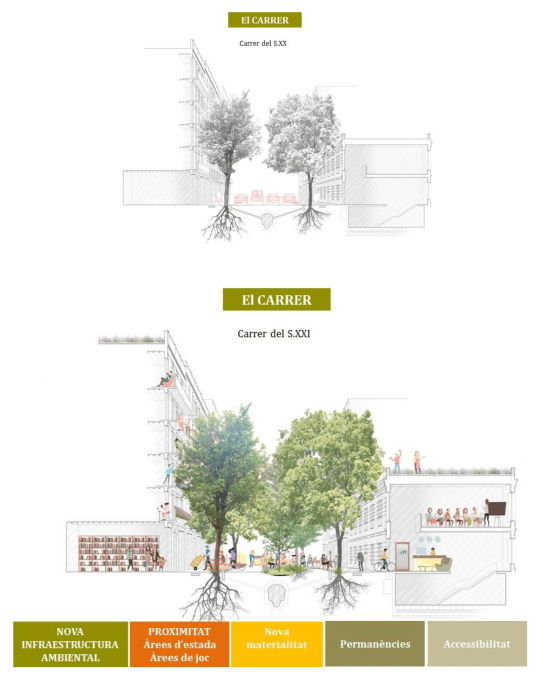
The city’s vision for the evolution of streets in the Barcelona superblock. Image Credits: Barcelona City Council
“It will be necessary to generate walking spaces, spaces that facilitate spontaneous children’s play and comfortable living spaces,” it writes in a press release [translated from Catalan]. “The design will have to allow for flexible spaces that can accommodate various occasional uses such as fairs, concerts and other acts. All with a feminist vision, prioritizing children and the elderly and promoting services and local trade.”
City authorities describe the aim as “a more sustainable model of public space, healthy and designed for people” — and one which “promotes social relations, which encourages local trade and focuses on the needs of children and seniors.”
They have also committed to maintain access to public transport throughout the superblocks.
Work on converting the first four streets is slated to begin in the first quarter of 2022: In Consell de Cent, Girona, Rocafort and Comte Borrell. City authorities have committed $44.8 million (€37.8 million) to these first transformations — though clearly a lot more public funding will be needed to deliver the full switch.
The coronavirus pandemic has acted as a small-scale opportunity for accelerating pedestrian-focused urban remodeling — enabling city authorities to expand Barcelona’s network of bike lanes during the relative quiet of lockdowns, and install some emergency pedestrian zones to expand outdoor space as an anti-COVID-19 measure.
Some street parking around the city has also been requisitioned and repurposed to make outdoor terrace space for cafés and bars during the pandemic.
But the need to reset an urban infrastructure that’s unhealthily monopolized by motorized traffic is an issue the city has been grappling with for decades — slowly chipping away at the problem with a variety of policies, such as those that allow for temporary road closures for local events and at weekends.
So for many Barcelona residents it’s not controversial to say that creating healthy, commercially active urban spaces means cars giving way to foot traffic. And the 2030 ‘Barcelona superblock’ looks like it will tip the balance for good.
That said, criticism of the project includes that it’s not radical enough — leaving a number of high-speed thoroughfares to keep on slicing right through the heart of the city. So Barcelona’s creep away from cars doesn’t yet look as radical as what’s being planned in Paris.
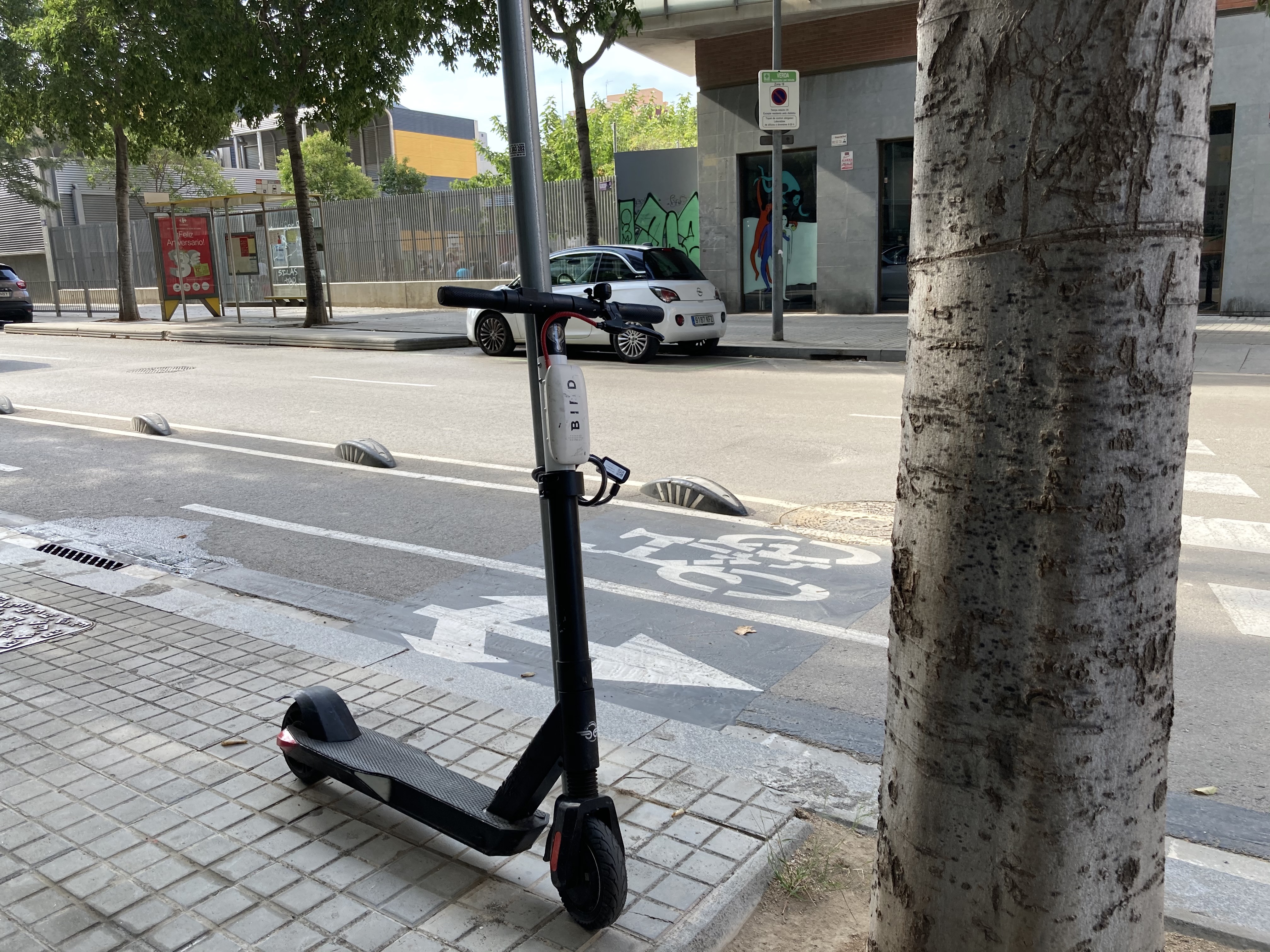
A Bird e-scooter parked next to a bike lane in Barcelona’s Poblenou district. Image Credits: Natasha Lomas / TechCrunch
London’s Low-Traffic Neighbourhoods
The UK capital has operated congestion charging in central zones of the city since 2003 — charging motorists to drive into the area in a bid to reduce road use during the busiest times. The policy made London a major European pioneer in applying controls on urban car use.
However, a lack of public and political consensus on the issue has restricted policy development for long periods — and even led to a rolling back, at the end of 2010, when then London mayor, Boris Johnson, scrapped a portion of the zone known as the western extension.
London’s huge population and sprawling size — with commercial zones tending to be clustered and concentrated away from large swathes of residential housing (which are often segregated by income) — means the issue of how to get around can be a divisive one, for people and businesses. So, it’s not an obvious candidate for going ‘car free’.
Yet, at the same time, London is extremely well served with public transport (buses, subways, trams and trains) — meaning plenty of journeys can be made without owning or using a private vehicle. There has also been investment in expanding the city’s network of cycle lanes in recent decades. And since 2010 a pay-as-you-go docked bike rental scheme has been in operation — racking up more than 10 million trips in total as of 2017.
Though, again, car-clogged streets and a Northern European climate can put limits on people’s willingness to brave the elements on two wheels.
Existing UK regulations have also held back the uptake of modern alternatives like e-scooters — though there are now moves to open up streets to this type of micromobility, with the city’s transport regulator preparing a trial for scooter rental companies.
While a lack of decisive political action to curb car use has undoubtedly contributed to decades of terrible air quality in London — with drastic impacts on public health (one study in 2015 suggested deaths from long term exposed to pollution could be as high as 9,500 annually) — rising awareness of the health risks associated with urban traffic has led city authorities to push policies that aim to deter the most polluting vehicles from driving through the congestion zone by applying a surcharge, Which appears to have led to a decline in peak pollution levels.
London’s ‘ultra-low emission zone’ (Ulez) will also be expanded to cover a larger area of the city next year. So, there’s been a centralized and somewhat sustained push to make urban car use cleaner and less harmful, even though there’s been an inconsistent approach to discouraging car use itself.
But, in a more radical recent development, the shock of the coronavirus has fuelled grassroots campaigns at a borough/neighbourhood level to bar through-traffic in residential neighbourhoods.
This is done by implementing so-called low traffic neighbourhoods (LTNs) which use a variety of interventions to limit traffic — such as strategically placed planters or bollards and/or timed road use restrictions to block rat runs.
Residents in a number of London boroughs who are sick of living alongside the noise and pollution generated by traffic have seized on the opportunity of COVID-19-related mobility restrictions to restrict access to roads in their immediate vicinity to through traffic.
Per Bloomberg, there were 114 plans for LTNs in the works in London as of late July.
There’s push and pull here too, with LTNs generating opposition, including complaints that rat-running cars are simply being displaced to other streets.
There are also important socioeconomic critiques that they disproportionately benefit wealthier areas at the expense of more deprived neighbourhoods.
Such opposition may in part reflect the relative rapidness of implementation since the pandemic — something a more participatory process and well-rounded monitoring and consultation might be able to avoid.
But for those lucky to be living in LTNs the gains look hard to ignore. “Now, instead of speeding cars, the streets carry street chalk, murals, flowers, and signs with children’s illustrations asking people to step out of their car and explore the neighborhood,” Bloomberg reports on the changed character of street life in one LTN.

Image Credits: Richard Baker / In Pictures / Getty Images
In May, London’s mayor, Sadiq Khan — who has pledged to make London carbon neutral by 2030 if he’s reelected next year — announced a ‘Streetspace’ plan: Pushing a range of policies aimed at “rapidly transforming London’s streets to accommodate a possible 10x increase in cycling and 5x increase in walking.”
The plan also explicitly encourages scooting alongside walking and cycling as an urban mobility priority in London.
Part of the motivation for the policy push has been trying to steer Londoners away from a mass regressive switch away from London’s public transport — and into cars — as lockdown restrictions ease yet the risk of COVID-19 infection lingers.
Khan’s Streetspace plan also voices support for LTNs. But, ultimately, the power to restrict London traffic rests with local councils (or central government) — leaving the mayor to “urge” government/borough councils to get on board with measures aimed at persuading Londoners to switch to “cleaner, more sustainable forms of transport”.
The lack of a central London authority with a policy plan for LTNs may limit how far or fast these through-traffic-free neighbourhoods can spread in the UK capital.
Nonetheless it’s an interesting development that shows how much appetite there is among Londoners to reclaim residential streets for neighbourhood life.
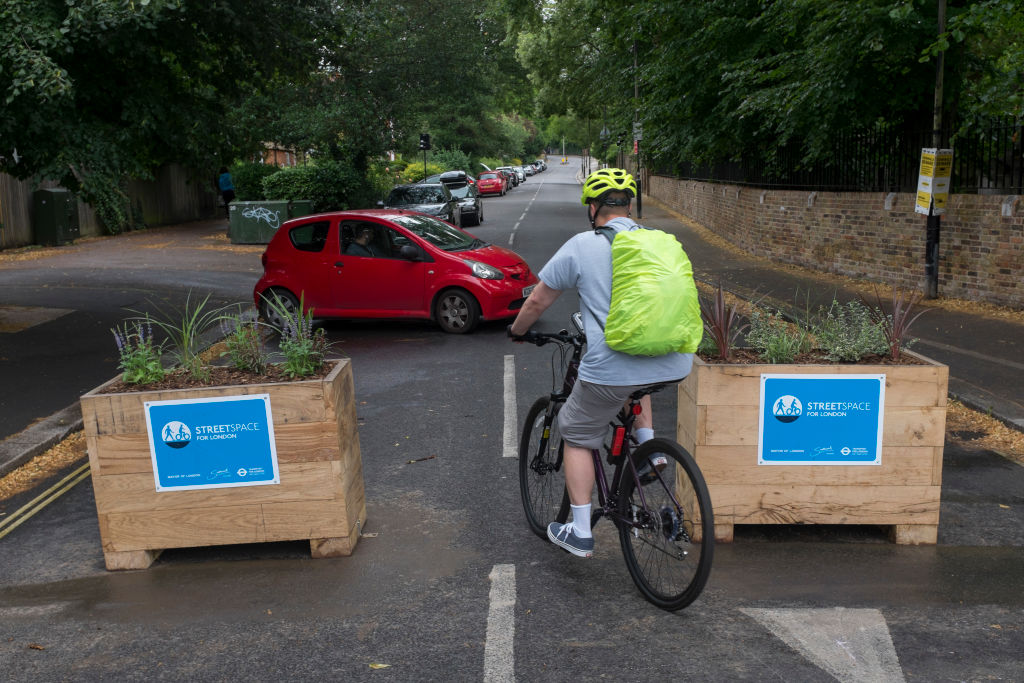
Image Credits: Photo by Richard Baker / In Pictures / Getty Images
Milan’s Open Streets
Italy’s industrial north was among the hardest hit regions in Europe during the first wave of the coronavirus pandemic. An extended lockdown was implemented — clearing cars off the streets of cities like Milan for months, as businesses got shuttered and residents were confined indoors — which in turn led to a noticeable improvement in air quality in a region infamous for pollution.
Since then, authorities in Milan have seized on the enforced break with a smog-filled ‘norm’ to push forward with an experimental citywide expansion of cycling lanes and pedestrianized zones — under a mobility plan called Strade Aperte (aka Open Streets) that’s aimed at adapting city infrastructure to find space for social distancing as urban life gets opened back up.
The Open Streets plan includes dropping the speed limit to 30kmph on a majority of Milan’s roads (replacing a 50kmph maximum), via signage and incorporating some structural elements for speed control; and adding 35km to its existing bike network before the end of the year.
The city launched its docked bike rental scheme, BikeMI, in 2008.
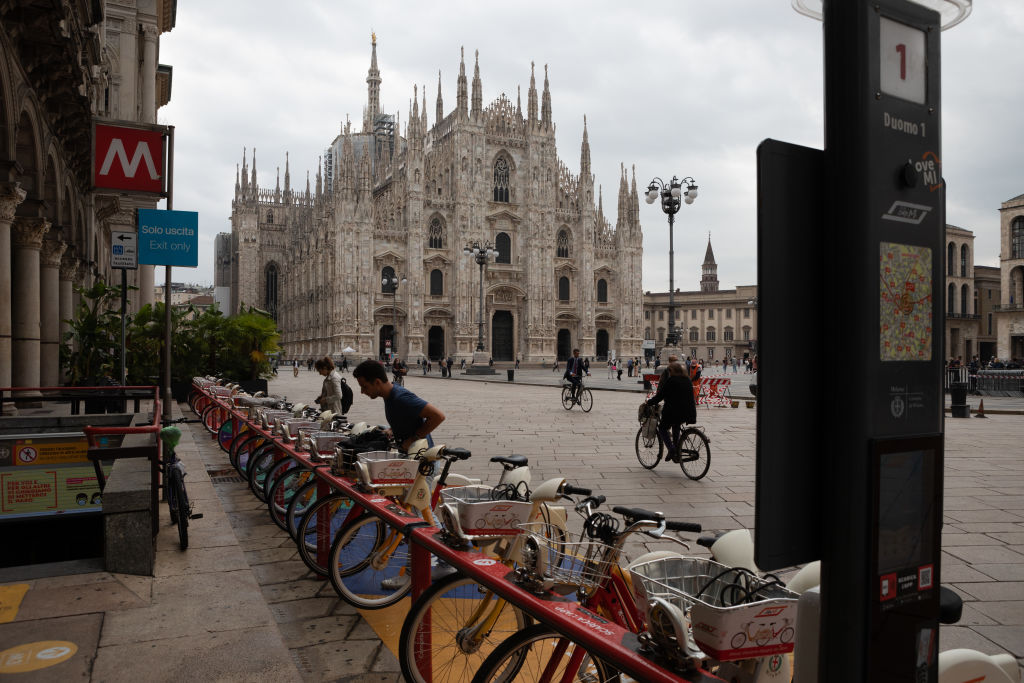
Image Credits: Emanuele Cremaschi / Getty Images
“As the Milan 2020 Adaptation Strategy foresees, the current health crisis can be an opportunity to decide to give more space to people and improve the environmental conditions in the city, increasing more sustainable, non-polluting, means of travel and redefining the use of streets and public spaces for commercial, recreational, cultural, and sport purposes, while respecting physical distance requirements,” city authorities write in a memo on the plan.
The overarching policy push is toward the same goal as Paris’ vision: Supporting what’s described as “the neighbourhood dimension” — aka making sure every citizen has access to almost all services within 15 minutes’ walk.
This is a strategic aim while residents are forced to live alongside the virus — and some of the measures are being couched as ‘temporary’.
But while the pandemic is acting as a catalyst/justification for rapid changes, city authorities were already looking for ways to repurpose urban infrastructure to deliver health benefits to citizens, environmental gains and boost local commerce by getting people out of cars and peddling/walking through the neighbourhood.
So, it’s hard to see where the impetus would come from to advocate a reversal back to noisier, more polluted, less playful streets.
In Milan, it’s the same story: The direction of urban travel is about rethinking streets as open public spaces for people and hyper-local micromobility, rather than letting cars colonize the commons and render its roads default highways elsewhere. Addio macchina.

Image Credits: Mairo Cinquetti / NurPhoto / Getty Images


